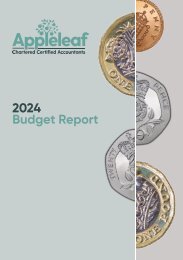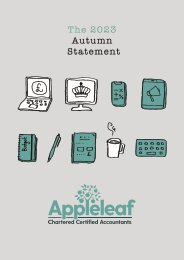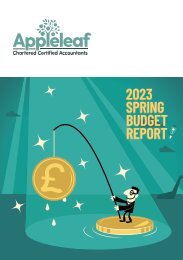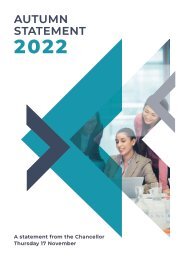Mini-Budget-2022
Create successful ePaper yourself
Turn your PDF publications into a flip-book with our unique Google optimized e-Paper software.
MINI BUDGET<br />
<strong>2022</strong><br />
A statement from the Chancellor<br />
Friday 23 September
THE GOVERNMENT’S PLANS FOR<br />
GROWTH<br />
Chancellor reveals his plan for growth<br />
The week leading up to Chancellor Kwasi Kwarteng’s ‘<strong>Mini</strong><br />
<strong>Budget</strong>’ may have been a short one due to the Queen’s funeral<br />
but the new government managed to fill it with a stream of<br />
policy announcements.<br />
The Health and Social Care Levy was expected to raise around<br />
£13 billion a year to fund health and social care and the<br />
Chancellor has confirmed that funding will be maintained at<br />
the same level as if the Levy was in place, funded from general<br />
taxation.<br />
Before Mr Kwarteng stood up to make his statement on ‘The<br />
Growth Plan’ much of what he had to say about energy support<br />
for businesses and households, bankers’ bonuses, investment<br />
zones and reversals to NICs had already been announced.<br />
The government also said that the Chancellor’s statement<br />
would not be subject to a forecast from the Office for <strong>Budget</strong><br />
Responsibility. However, this did not stop the media from<br />
dubbing this event a <strong>Mini</strong> <strong>Budget</strong>.<br />
The Growth Plan set out a new approach to the economy built<br />
around three central priorities:<br />
• reforming the supply-side of the economy<br />
• maintaining a responsible approach to public finances<br />
• cutting taxes to boost growth.<br />
National Insurance contributions<br />
In September 2021 the government published its proposals<br />
for new investment in health and social care in England. The<br />
proposals were intended to lead to a permanent increase<br />
in spending not only in England but also by the devolved<br />
governments. To fund the investment the government<br />
introduced a UK-wide 1.25% Health and Social Care Levy based<br />
on the National Insurance contributions (NICs) system but<br />
ringfenced for health and social care.<br />
The Health and Social Care Levy Act provided for a temporary<br />
1.25% increase to both the main and additional rates of Class 1,<br />
Class 1A, Class 1B and Class 4 NICs for <strong>2022</strong>/23. From April 2023<br />
onwards, the NIC rates were intended to revert back to 2021/22<br />
levels and be replaced by a new 1.25% Health and Social Care<br />
Levy.<br />
Comment<br />
According to the government, not proceeding with the Levy will<br />
reduce tax for 920,000 businesses by nearly £10,000 on average<br />
next year.<br />
For SMEs, the government predicts that the savings will be around<br />
£4,200 on average for small businesses and £21,700 for medium<br />
sized firms from 2023/24.<br />
In addition, it will help almost 28 million people across the UK save<br />
£330 on average in 2023/24, with an additional saving of around<br />
£135 on average this year.<br />
More detail for employees and employers<br />
The changes take effect for payments of earnings made on or<br />
after 6 November <strong>2022</strong>, so:<br />
• primary Class 1 NICs (employees) will generally reduce from<br />
13.25% to 12% and 3.25% to 2% and<br />
• secondary Class 1 NICs (employers) will reduce from 15.05%<br />
to 13.8%.<br />
However, the new Chancellor has decided to:<br />
• reverse the temporary increase in NICs from November and<br />
• cancel the Health and Social Care Levy completely.<br />
The effect on Class 1A (payable by employers on taxable<br />
benefits in kind) and Class 1B (payable by employers on PAYE<br />
Settlement Agreements) NICs will effectively be averaged over<br />
the <strong>2022</strong>/23 tax year, so that the rate will generally be 14.53%.<br />
1
Comment<br />
The government hopes that most employees will receive the<br />
NICs reduction directly via the payroll in their November pay but<br />
acknowledges that some will have to wait until December or<br />
January, depending on the complexity of their employer’s payroll<br />
software.<br />
More detail for the self-employed<br />
Following the principle detailed above, the changes to Class 4<br />
NICs will again be averaged across <strong>2022</strong>/23, so that the rates will<br />
be 9.73% and 2.73%.<br />
Income tax<br />
Income tax rates<br />
The government had previously announced that there would<br />
be a cut in the basic rate of income tax, from 20% to 19%, from<br />
April 2024. This is now being accelerated so that it takes effect<br />
from April 2023.<br />
Comment<br />
The government states that this reduction is worth over £5 billion<br />
for workers, savers and pensioners. Also, that 31 million taxpayers<br />
will benefit in 2023/24, with an average gain of £170.<br />
In addition, to ‘incentivise enterprise and hard-work and<br />
simplify the tax system’, the government will abolish the 45%<br />
additional rate of income tax from April 2023. Consequently,<br />
there will be a single higher rate of income tax of 40%.<br />
These changes will apply in Scotland as the rules on dividends<br />
apply to the whole of the UK.<br />
Business<br />
Corporation tax rates<br />
It had been previously announced that the rate of corporation<br />
tax would increase for many companies from April 2023 to<br />
25%. This change will now not go ahead, leaving the rate of<br />
corporation tax at 19% for the majority of companies.<br />
Comment<br />
The 19% UK corporation tax rate is significantly lower than the rest<br />
of the G7 and the lowest in the G20.<br />
In line with this change, the Bank Corporation Tax Surcharge<br />
will remain the same, as will the Diverted Profits Tax.<br />
Capital allowances<br />
The Annual Investment Allowance (AIA) gives a 100% write-off<br />
on certain types of plant and machinery, including cars with<br />
zero emissions, up to certain financial limits per 12-month<br />
period. The limit has been £1 million for some time but<br />
was scheduled to reduce to £200,000 from April 2023. The<br />
government has announced that the temporary £1 million level<br />
of the AIA will become permanent and the proposed reduction<br />
will not occur.<br />
Comment<br />
These changes will generally apply to taxpayers in England, Wales<br />
and Northern Ireland. It remains to be seen what the Scottish<br />
government will do in relation to the setting of rates on non-savings<br />
income.<br />
There are a number of tax consequences which stem from<br />
these changes. One of them is the amount of tax relief given at<br />
source on pension contributions and Gift Aid donations. This<br />
is currently given at the basic rate of 20%. The government has<br />
stated that there will be a four-year transition period for Gift<br />
Aid relief to maintain the income tax basic rate relief at 20%<br />
until April 2027. This will support almost 70,000 charities and<br />
is worth over £300 million. However, there was little comment<br />
on pension contributions other than that there will also be<br />
a one-year transitional period for Relief at Source pension<br />
schemes to permit them to continue to claim tax relief at 20%.<br />
Dividends<br />
From April 2023:<br />
• the dividend ordinary rate of 8.75% will reduce to 7.5%<br />
• the dividend upper rate of 33.75% will reduce to 32.5% and<br />
• the dividend additional rate will be abolished.<br />
As corporation tax due on directors’ overdrawn loan accounts<br />
is paid at the dividend upper rate, it will also reduce to a 32.5%<br />
charge for loans made on or after 6 April 2023.<br />
Up to 31 March 2023, companies investing in qualifying<br />
new plant and machinery are able to benefit from capital<br />
allowances, generally referred to as ‘super-deductions’. These<br />
reliefs are not available for unincorporated businesses.<br />
Interestingly, these allowances were not mentioned, other<br />
than minor amendments to the current rules, so it appears the<br />
scheduled withdrawal of them will occur in 2023.<br />
Comment<br />
Businesses incurring expenditure on plant and machinery should<br />
carefully consider the timing of their acquisitions to optimise their<br />
cashflow.<br />
2
Seed Enterprise Investment Scheme<br />
From April 2023, companies will be able to raise up to £250,000<br />
of Seed Enterprise Investment Scheme (SEIS) investment, a<br />
two-thirds increase. To enable more companies to use SEIS, the<br />
gross asset limit will be increased to £350,000 and the age limit<br />
from two to three years. To support these increases, the annual<br />
investor limit will be doubled to £200,000.<br />
Company Share Option Plan<br />
From April 2023, qualifying companies will be able to issue up<br />
to £60,000 of Company Share Option Plan (CSOP) options to<br />
employees, twice the current £30,000 limit. The ‘worth having’<br />
restriction on share classes within CSOP will be eased, better<br />
aligning the scheme rules with the rules in the Enterprise<br />
Management Incentive scheme and widening access to CSOP<br />
for growth companies.<br />
Investment Zones aim to encourage rapid<br />
development<br />
As part of the government’s plan to drive economic growth<br />
and encourage development the Chancellor confirmed that<br />
Investment Zones will be established across the UK.<br />
These zones will benefit from lower taxes and liberalised<br />
planning frameworks to encourage business investment.<br />
The government is already in discussions with 38 local<br />
authorities to establish investment zones in England. In<br />
addition, it says it will work closely with the devolved<br />
administrations to offer the same opportunities in Scotland,<br />
Wales and Northern Ireland.<br />
Businesses in designated areas in investment zones will<br />
benefit from 100% business rates relief on newly occupied and<br />
expanded premises.<br />
In addition, businesses will receive full Stamp Duty Land<br />
Tax relief on land bought for commercial or residential<br />
development and a zero rate for employer NICs on new<br />
employee earnings up to £50,270 per year.<br />
There will also be a 100% first year enhanced capital allowance<br />
relief for plant and machinery used within designated sites and<br />
accelerated Enhanced Structures and Buildings Allowance relief<br />
of 20% per year.<br />
As well as time-limited tax benefits there will be designated<br />
development sites that will release more land for housing and<br />
commercial development in the zones. The need for planning<br />
applications will be minimised and streamlined.<br />
Stamp Duty Land Tax<br />
A number of changes are made to the Stamp Duty Land Tax<br />
(SDLT) regime. Generally, the changes increase the amount<br />
that a purchaser can pay for residential property before they<br />
become liable for SDLT.<br />
The residential nil rate tax threshold is increased from £125,000<br />
to £250,000.<br />
The nil rate threshold for First Time Buyers’ Relief is increased<br />
from £300,000 to £425,000 and the maximum amount that an<br />
individual can pay while remaining eligible for First Time<br />
Buyers’ Relief is increased to £625,000.<br />
The changes apply to transactions with effective dates on and<br />
after 23 September <strong>2022</strong> in England and Northern Ireland.<br />
These changes do not apply to Scotland or Wales which operate<br />
their own land transactions taxes.<br />
There are no changes in relation to purchases of non-residential<br />
property.<br />
Residential<br />
Band £<br />
Rate<br />
%<br />
Non-residential<br />
Band £<br />
Rate<br />
%<br />
0 - 250,000 0 0 - 150,000 0<br />
250,001 - 925,000 5 150,001 - 250,000 2<br />
925,001 - 1,500,000 10 Over 250,000 5<br />
Over 1,500,000 12<br />
Residential rates may be increased by 3% where further<br />
residential properties are acquired.<br />
Other comments<br />
There were a number of other interesting comments made<br />
by the Chancellor which suggest future policies and changes,<br />
although lacking detail at the moment.<br />
IR35 and off-payrolling<br />
Over the last 20 years, there have been numerous changes to<br />
the tax system to try and address ‘disguised employment’ and<br />
to generate additional tax and NICs accordingly. In a surprise<br />
announcement, the government has stated that it will repeal<br />
the off-payroll working rules from 6 April 2023. From this date,<br />
workers providing their services via an intermediary will once<br />
again be responsible for determining their employment status<br />
and paying the appropriate amount of tax and NICs.<br />
Comment<br />
According to the government, this will free up time and money for<br />
businesses that engage contractors, that could be put towards<br />
other priorities. The change will also reduce the risk that genuinely<br />
self-employed workers are impacted by the off-payrolling rules.<br />
3
Infrastructure<br />
The Chancellor announced plans to accelerate new roads,<br />
rail and energy infrastructure with new legislation which will<br />
cut barriers and restrictions. This will make it quicker to plan<br />
and build new roads, speeding up the deployment of energy<br />
infrastructure such as offshore wind farms and streamlining<br />
environmental assessments and regulations.<br />
Comment<br />
According to the government, in 2021 it took 65% longer to get<br />
consent for major infrastructure projects than in 2012.<br />
State benefits<br />
Universal Credit claimants who earn less than the equivalent of<br />
15 hours a week at the National Living Wage will be required to<br />
meet regularly with their work coach and take active steps to<br />
increase their earnings or face having their benefits reduced,<br />
broadly from January 2023. Jobseekers over the age of 50 will<br />
also be given extra time with Jobcentre work coaches, to help<br />
them return to the job market.<br />
Further announcements<br />
Over the next few weeks, the government will set out further<br />
details of plans to speed up digital infrastructure, reform<br />
business regulation, increase housing supply, improve our<br />
immigration system, make childcare cheaper, improve farming<br />
productivity and back the financial services sector.<br />
Government announces plans to help<br />
cut energy bills for businesses<br />
On 21 September <strong>2022</strong> the government announced a new<br />
scheme, the Energy Bill Relief Scheme, which is designed to<br />
cut energy prices for non-domestic energy customers, such as<br />
businesses, charities and public sector organisations. The new<br />
scheme is in addition to the recently announced Energy Price<br />
Guarantee for households.<br />
VAT-free shopping areas<br />
The government will introduce a modern, digital, VAT-free<br />
shopping scheme with the aim of providing a boost to the high<br />
street and creating jobs in the retail and tourism sectors. The<br />
delivery will include modernising the scheme that currently<br />
operates in Northern Ireland and introducing a new digital<br />
scheme in Great Britain. The new VAT-free shopping scheme<br />
for non-UK visitors to Great Britain will enable them to obtain<br />
a VAT refund on goods bought in the high street, airports and<br />
other departure points and exported from the UK in their<br />
personal baggage.<br />
Alcohol duties<br />
Reforms to modernise alcohol duties will also be taken forward<br />
and the government has published a consultation response<br />
on these plans. The reforms will be implemented from<br />
1 August 2023. The government is also freezing the alcohol duty<br />
rates from 1 February 2023 to provide additional support to the<br />
sector.<br />
The scheme will apply to fixed contracts agreed on or after<br />
1 April <strong>2022</strong> in addition to deemed, variable and flexible tariffs<br />
and contracts. Running for an initial six-month period, the<br />
scheme will apply to energy usage from 1 October <strong>2022</strong> to<br />
31 March 2023. According to the government, savings will first<br />
be seen in businesses’ October bills.<br />
Businesses are not required to take action or apply for the<br />
scheme, support will be automatically applied to bills.<br />
The government intends to conduct a review of the scheme in<br />
three months to assess:<br />
• how effective it has been in giving support to vulnerable,<br />
non-domestic customers<br />
• which groups of non-domestic customers remain vulnerable<br />
to energy price rises<br />
• the extent to which the scheme could either be extended or<br />
further targeted.<br />
Support after 31 March 2023 will be determined following the<br />
review.<br />
4
Energy Price Guarantee plan caps<br />
household bills<br />
Prime <strong>Mini</strong>ster Liz Truss announced the Energy Price<br />
Guarantee (EPG) for households on 8 September <strong>2022</strong> which<br />
will apply from the start of October <strong>2022</strong>. The EPG means<br />
that an average household will pay no more than £2,500 per<br />
year for each of the next two years. It comes in addition to the<br />
£400 Energy Bill Support Scheme and will save the average<br />
household at least £1,000.<br />
The EPG limits the price suppliers can charge customers for<br />
energy supplies. This takes account of temporarily removing<br />
green levies, worth around £150, from household bills. The<br />
guarantee will supersede the existing energy price cap.<br />
Schemes previously funded by green levies will also continue<br />
to be funded by the government during this two-year period to<br />
ensure the UK’s investment in homegrown, secure renewable<br />
technologies continues.<br />
New plan for patients aims to tackle<br />
NHS backlog<br />
Health and Social Care Secretary Thérèse Coffey unveiled the<br />
government’s new ‘Our plan for patients’ on 22 September <strong>2022</strong>,<br />
which aims to tackle NHS backlogs.<br />
Under the plan, those households who do not pay directly for<br />
mains gas and electricity, such as those living in park homes or<br />
on heat networks, will be no worse off and will receive support<br />
through a new fund.<br />
The government estimates that the EPG will deliver substantial<br />
benefits to the economy, boosting growth and curbing inflation<br />
by four to five percentage points, which will in turn reduce the<br />
cost of servicing the national debt.<br />
The government will provide energy suppliers with the<br />
difference between this new lower price and what energy<br />
retailers would charge their customers if this were not in place.<br />
The centrepiece of the plan is the expectation that everyone<br />
who needs an appointment at a GP practice should get one<br />
within two weeks, with patients with the most urgent needs<br />
being seen the same day.<br />
The plan also includes changing funding rules to recruit<br />
extra support staff so that GPs can focus on treating patients.<br />
The government says this will free up over one million<br />
appointments per year.<br />
There will also be ‘more state-of-the art telephone’ systems to<br />
make it easier for patients to get through to their GP surgeries.<br />
In addition, more information will be available for patients,<br />
with appointments data published at a practice level for the first<br />
time ever.<br />
Pharmacies will help ease pressures on GPs and free up time<br />
for appointments by managing and supplying more medicines<br />
without a GP prescription and taking referrals from emergency<br />
care for minor illnesses.<br />
Disclaimer: Whilst we take care to ensure the accuracy of this document, no responsibility for loss incurred by any person acting or refraining from action as a result of this information can be<br />
accepted by the authors or firm.<br />
5

















